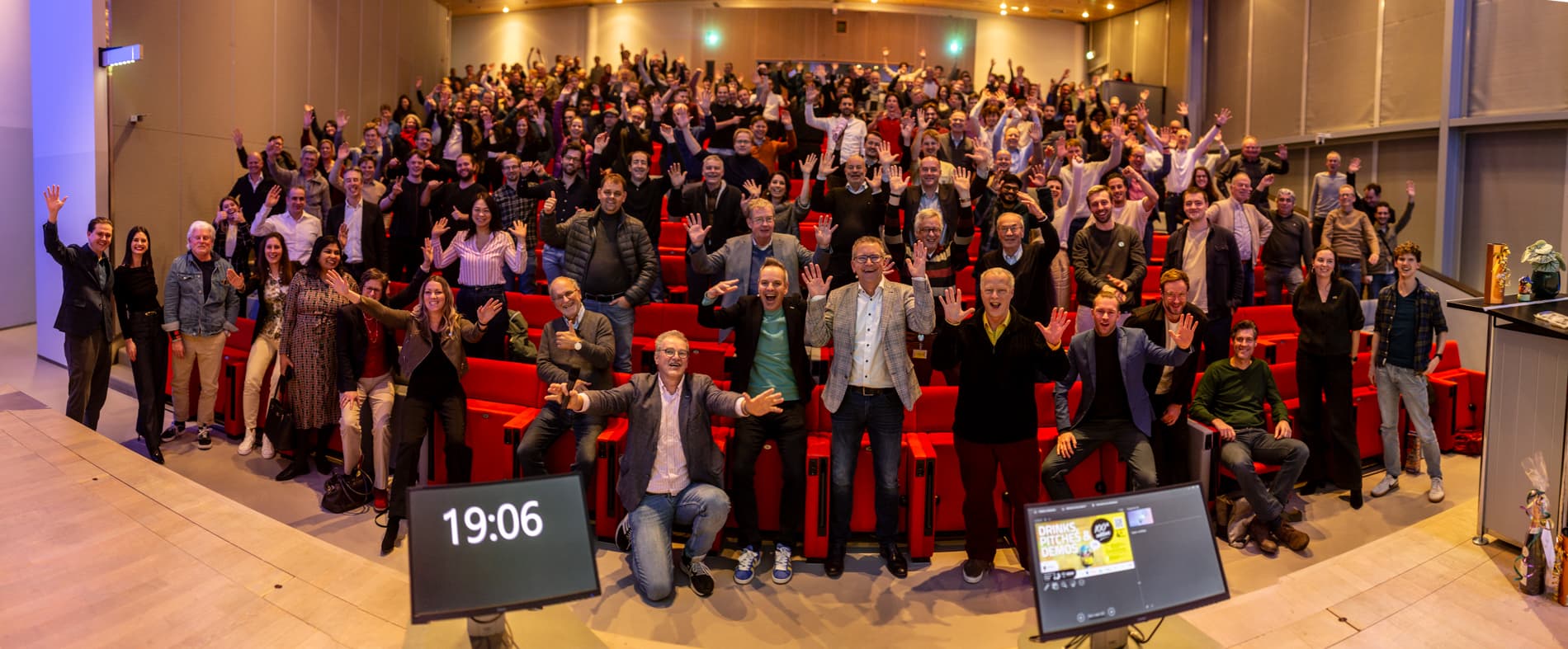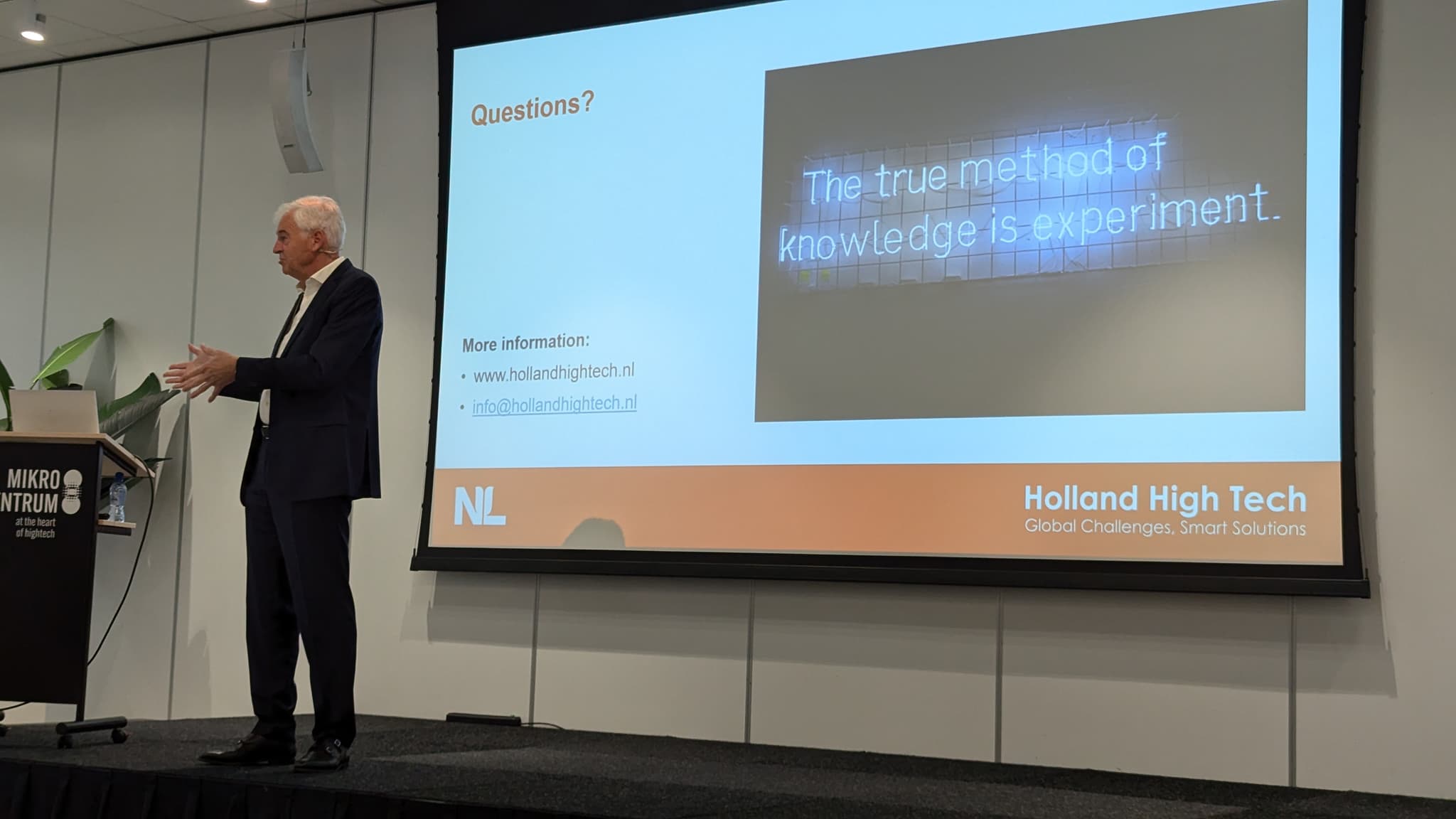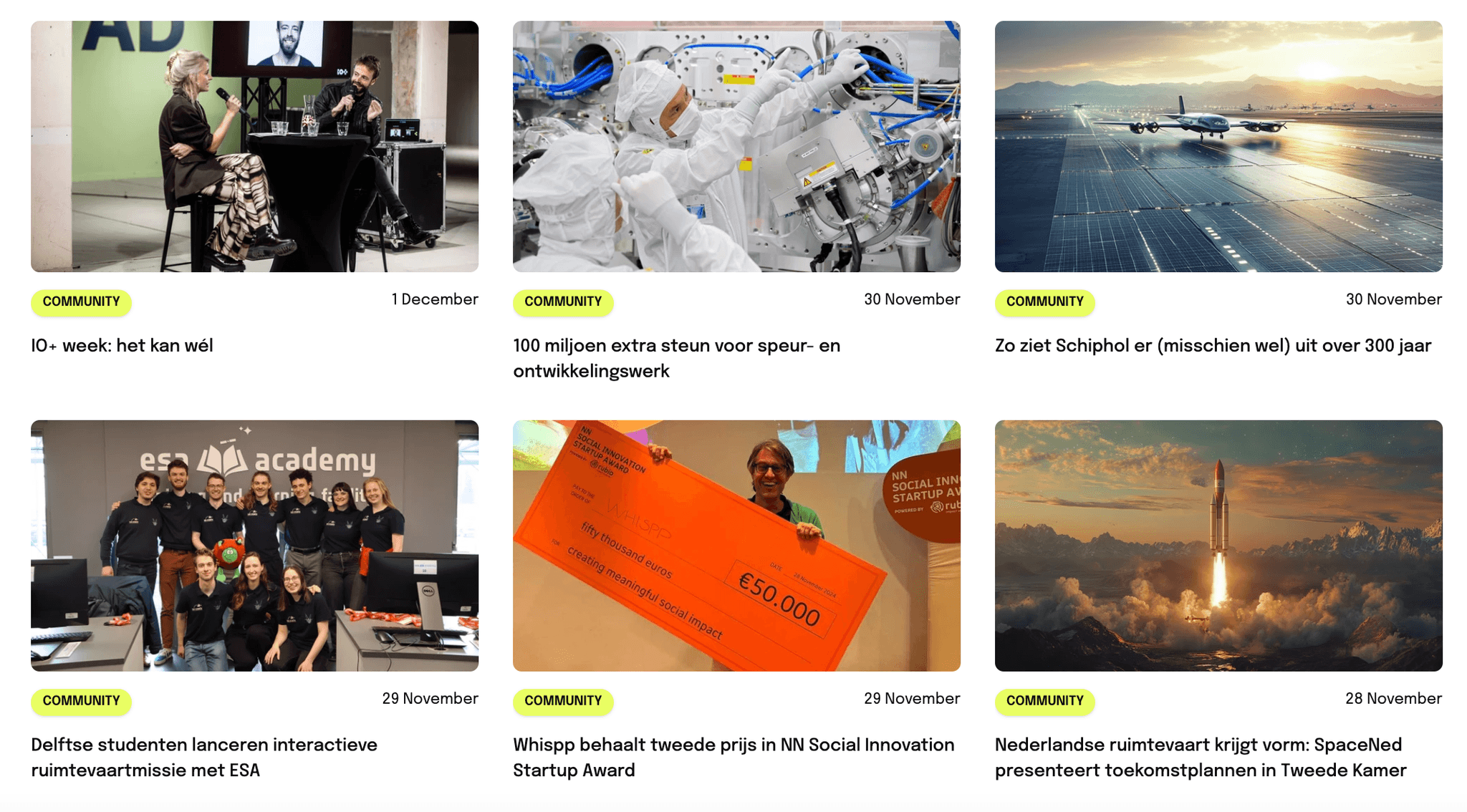A tribute to the innovative community
In a series of retrospective articles we look at 2025's crucial moments within IO+'s five main categories. Today's focus is on the innovation community, the connecting element between our other four key themes: data+, chip+, green+ and bio+.
Published on December 29, 2024
.png&w=2048&q=75)
Bart, co-founder of Media52 and Professor of Journalism oversees IO+, events, and Laio. A journalist at heart, he keeps writing as many stories as possible.
Communities - the theme of this retrospective episode - are both connectors and accelerators. They are groups of people or organizations that, through optimal interrelationships, can extremely strengthen the sum of individual strengths and create an unfair advantage: an inevitable supremacy that can hardly be copied and provides a long-term benefit. Communities enable a group of individuals to rise above themselves. At IO+, we attach great importance to communities for a good reason - we have even made them a separate category alongside the themes data+, chip+, green+, and bio+.
We come across examples of thriving communities every day. Think of the ecosystems around the student teams at many technical universities, as well as ASML's supply chain or our own Gerard & Anton Community. A critical component in any community is a playing field within which chance and human action can interact in a way that increases the likelihood of positive outcomes. Participants are open to the opportunities that present themselves simply because they know it is mainly a matter of recognizing them in time.
Serendipity
'Connecting the dots' (referring to Christian Busch) is essential in this regard. Seemingly unrelated events often turn out to be interconnected after all. Whoever manages to discover the dots and then connect them - together with the other community members - wins the competition. And this is where the magic concept of 'serendipity' comes in, an essential element within innovation-oriented communities. Serendipity (“finding something unexpected and useful while the finder was looking for something completely different”) is not random luck; it results from conscious openness and willingness to seize opportunities as they arise. Genuine communities reinforce this principle by providing the space, resources, and networks where individuals can prepare and take advantage of the unexpected. In other words, serendipity exists only by the grace of cleverly created circumstances.
Thriving communities and open innovation go hand in hand. In a world full of complexity and unpredictability, the true measure of progress lies not in rigid control or isolation but in the vibrant, collaborative essence of communities. These communities, built on trust, openness, and diversity, provide the fertile ground where serendipity can flourish, where chance meets preparation and extraordinary results emerge from the ordinary.
Success and happiness are often dismissed as pure chance, but history tells a different story. As Louis Pasteur once said, “Happiness is where the prepared mind meets the opportunity.” While serendipity cannot be controlled entirely, there are ways to develop an environment where serendipity can thrive, such as keeping an open mind and taking advantage of unexpected connections.
A welcome addition to our democratic toolbox
This is precisely what we have had the opportunity to witness up close several times in 2024. Take the AI Pitch Competition, a competition between 12 AI startups with a grand prize of €50,000 for the winners at the end of the three-month process. Each participating startup turned out to be many times wiser than at the beginning thanks to the dots recognized and picked up along the way. By the way, the end of the journey was not the end for any of the participants. They are all still busy, using their recently acquired network. Their new community.
One of the participants in this competition also makes the importance of communities clear in daily practice. Dembrane has found a way to survey large groups of citizens about a given topic and, with the help of artificial intelligence, distill not only the most important conclusions but also the nuances of what is really going on within the group, including the corresponding sentiments. On top of that, Dembrane's tool provides a rich array of classifiable quotes that can be directly linked to the (sub)question in question. All in all, this provides a widely supported and strongly substantiated picture on every issue we want to unravel. A more than welcome addition to our democratic toolbox.
Gerard & Anton Community
It should also come as no surprise that last summer, Dembrane was one of ten winners of a Gerard & Anton Award. These awards have been presented for ten years now to the startups whose socially relevant deeds we expect in the coming years. The fact that 93 of the 100 former winners are indeed still tackling the most crucial issues of our time (think energy storage, CO2 reduction, mobility, healthcare) is in itself a great success, but at least as interesting is the fact that these organizations together with the surrounding network have become a community in themselves. For a few years, we no longer speak of the Gerard & Anton Awards but of the Gerard & Anton Community.
It could hardly be otherwise because, with about 15 events a year, as well as a website, a monthly newsletter, WhatsApp channels, and a LinkedIn group, there are now so many ways for the group members to meet each other that the 'community' became a matter of course. This was again evident when we hosted our 100th Drinks, Pitches & Demos. With some 300 engaged guests, there was hardly a seat left in the High Tech Campus conference center.

Drinks Pitches & Demos, episode 100. © Bram van Dal
The Gerard & Anton community shows that a “serendipity field” is more than a metaphor; it is the conscious creation of environments where unexpected connections can thrive. In such spaces, diverse perspectives collide, and new ideas emerge. This is not about directing outcomes but about creating conditions for meaningful interactions. Communities like the Gerard & Anton community provide precisely this context. They inspire creativity and collaboration by bringing diverse people together. Anyone who attended one of our events understands exactly what we mean.
Student teams
The biggest obstacle to serendipity is not the lack of opportunity but the blinders of our biases. Preconceived ideas about how the world works can obscure potential connections and opportunities. How that can be broken is shown by the student teams that have made a huge advance in recent years, especially at technical universities. Everyone remembers Solar Team Eindhoven, which became the world champion time and again with its solar cars and from which startup Lightyear could also emerge. But student teams today come in all shapes and sizes, on various topics. But all of them are multidisciplinary (students from different backgrounds work together), there is always a connection with the business community (sometimes through sponsorship, often through business agreements), and there is an almost-naïve ambition to improve the world. All that together ensures that opportunities arise and are seen and acted upon. It's serendipity at work.
Student teams challenge common preconceptions by embracing diversity and nurturing curiosity. They celebrate the unknown and enable people to step outside their comfort zones, making discoveries possible. So, it should come as no surprise that IO+ continues to enjoy spotlighting these young entrepreneurs in 2025 as well. Here are a few examples from last year.
Expat community
Sometimes, communities arise not out of opportunity but out of necessity. The dozens of expat communities in the Netherlands are an example of this. Just as Dutch people in New Zealand exchange packages of chocolate sprinkles and stroopwafels, Indians in the Netherlands clump together to discuss each other's experiences in the new country over a chicken tikka masala. Recurring theme: our strange habits. In our Dutch Diaries series, we bring the stories of expats who moved to the Netherlands to work in the tech and innovation sector. Why did they decide to come here? What do they like most about the Netherlands? What would they change? The fact that the series is written by our very own expat (Sardinian Mauro Mereu) makes it all even better.
Being open to the unexpected is the hallmark of resilient communities, whether they consist of students, expats or startup founders. In these spaces, individuals learn to see beyond chaos and find opportunities where others see randomness. This thinking was also palpable at the (third) Level Up event, for which IO+ was privileged to act as a media partner. Here, innovators came together with investors and the surrounding network, creating surprising collaborations. As it works for all successful communities, it was again about “expecting the unexpected” and the tools to turn surprises into growth opportunities.
Dutch Innovation
Marc Hendrikse gave an excellent lecture a few months ago on the power of “Dutch Innovation” as a trademark. According to him, collaboration, independence, and an anti-hierarchical mentality are crucial. They are elements that distinguish Dutch innovation culture from that in the countries around us, especially Germany - and together produce a sense of community that has made Dutch innovation sector a close-knit community. Within it, we see a combination of trust, diversity and intentional interaction to foster a culture of collaboration. In these communities, the boundaries between disciplines blur and innovation becomes second nature.
About the impact of that independent spirit as an essential component of the Dutch innovation community, Hans Krikhaar recently shared a nice anecdote with us: “In the Netherlands, if you have an engineering department of 20 people, you have the brainpower of 19 people. Because nobody listens to the boss. But if you have an engineering department of 20 people in certain foreign countries, you have the brainpower of just one person, because everyone has to listen to the boss.”
This is Dutch innovation
In the run-up to the Dutch Innovation Days 2023, held annually in Enschede, we asked various players within the Dutch innovation ecosystem what they believe characterizes Dutch innovation. In a three-part series, we examined the content, opportunities and limitations of this concept. Here is the result, courtesy of Peter Oosterwijk, Hille van der Kaa, Jeroen Wijering, Bram Nauta, Carina Weijma, Khashayar Mansourizadeh, Cees Links, Martin van den Brink, Fred Roozeboom, Maarten Steinbuch, Marc Hendrikse, Ton van Mol. Bert-Jan Woertman, Frank Eijssens, and Yvette Ruts-Wolters:
2 - Innovation thanks to Dutch sobriety
3 - The drive for impact is the driving force behind innovation in the Netherlands
ASML's supply chain
The aforementioned Marc Hendrikse, until recently the figurehead of the Top Sector High Tech Systems & Materials, sees in Philips and the large supply chain that emerged around that company and its subsidiaries the prime example of such an entrepreneurial innovation community. “The desire for autonomy catalyzed innovation and led to a collaborative spirit that is still alive today,” he says. From Philips, it went to ASML, Thermo Fisher and NXP, all once part of the parent company but now giants in their own right. ASML, in particular, is currently driving the chain, with enormous impact, especially in the Netherlands. The trick? Get all your first- and second-tier suppliers to innovate themselves. In other words, by not supplying them with a blueprint of an exact production order, but asking them to solve a problem, you ensure that that entire supply chain strengthens.
By the way, it's no coincidence that the Brainport ecosystem is also closely connected to the Gerard & Anton Community.
The Dutch innovation ecosystem thus developed into a flexible, collaborative supply chain model. This allowed companies to specialize and collaborate with others, maximizing expertise at every step. Today, the Netherlands has a robust network of supply chains, with many Dutch companies playing crucial roles in global industries - semiconductors at the forefront.

Marc Hendrikse
Many examples
Fortunately, there are many examples of well-functioning communities, also outside the world of innovation. Some are at the neighborhood level, others are within associations, or they are along the lines of political, economic, or religious beliefs. As long as they are not used to opposing other communities (we know the most dramatic examples all too well, unfortunately), they can become tools to counteract polarization. A final aspect of a successful and sustainable community should, therefore, not go unmentioned in this story: the willingness to admit new forces so that the community can also continue to develop. So that new “dots” emerge to connect with. In religious communities or other forms of cooperation based on dogma, this is a lot more difficult than, say, for the Gerard & Anton Community. Openness is essential.
A prime example of such a community is the library, a beautiful people's palace welcoming everyone. In the library, you always meet someone who looks like you, but simultaneously, you can talk to people from completely different backgrounds. You are connected by the common urge to help develop yourself and that other person. The resulting social system can serve as an effective antidote in times of polarization. This is where communities are strengthened and opportunities are created.
So, also in 2025, you will often see the label 'community' above our articles. In those stories, we will connect the dots, welcome the unexpected, and continue to make the impact of it all visible. By now, I'm sure you understand why :-)

